The Hussites
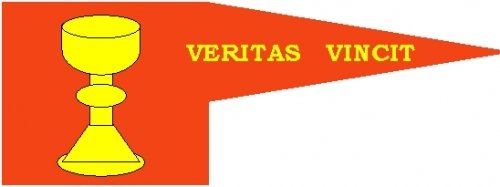
Hussite Wars, 1420–1434 'Veritas Vincit' (Truth Prevails)
Background
The Kingdom of Bohemia was predominantly Slavic in ethnicity, having been established by the Slavs who settled in what had been a Celtic region of Eastern Europe. In the 13th century, the presence of large silver deposits and the willingness of its rulers to encourage ethnic Germans to exploit and develop this wealth resulted in a large German minority in Bohemia. The Germans came to occupy positions of prominence in the trade guilds and churches in the urban areas like Prague, Kutna Hora (Kuttenberg), Nemecky Brod (Deutchbrod). This influx of Germans, and their subsequent prominent role created considerable resentment in the Slavic native population.
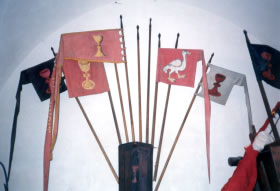
Hussite Battle Flags
Jan Hus (1371 - 1415) , an ethnic Slav, graduated from Charles University (Univerzita Karlova) in Prague and in 1398 began lecturing there. He was rector from 1402-03 and 1409-10 and was an extremely popular clergyman among the Slavs, both noble and peasant preaching to both on the hills outside Prague. He became a proponent of the ideas of the English reformer and theologian John Wycliffe. Huss like Wycliffe denounced the immorality of clergy, the sale of indulgences, accumulation of wealth by the clergy and the church and saw the Bible as the final authority in ecclesiastical matters. He was a proponent of the laity taking communion in both kinds, that is to say the bread and the wine, at a time when only the clergy received communion in both kinds. He translated the Bible into the language of the people and said “ Women were made in the image of God and should fear no man” setting the stage for women to preach at Hussite services and participate in governing councils, not to mention fight beside their men in battle. It was the teaching and writing about his radical ideas that brought the attention of the Pope to Jan Hus. Hus was commanded by one of, at the time two, Popes to appear before a General Council of the Church in November 1414 at Constance in Germany.
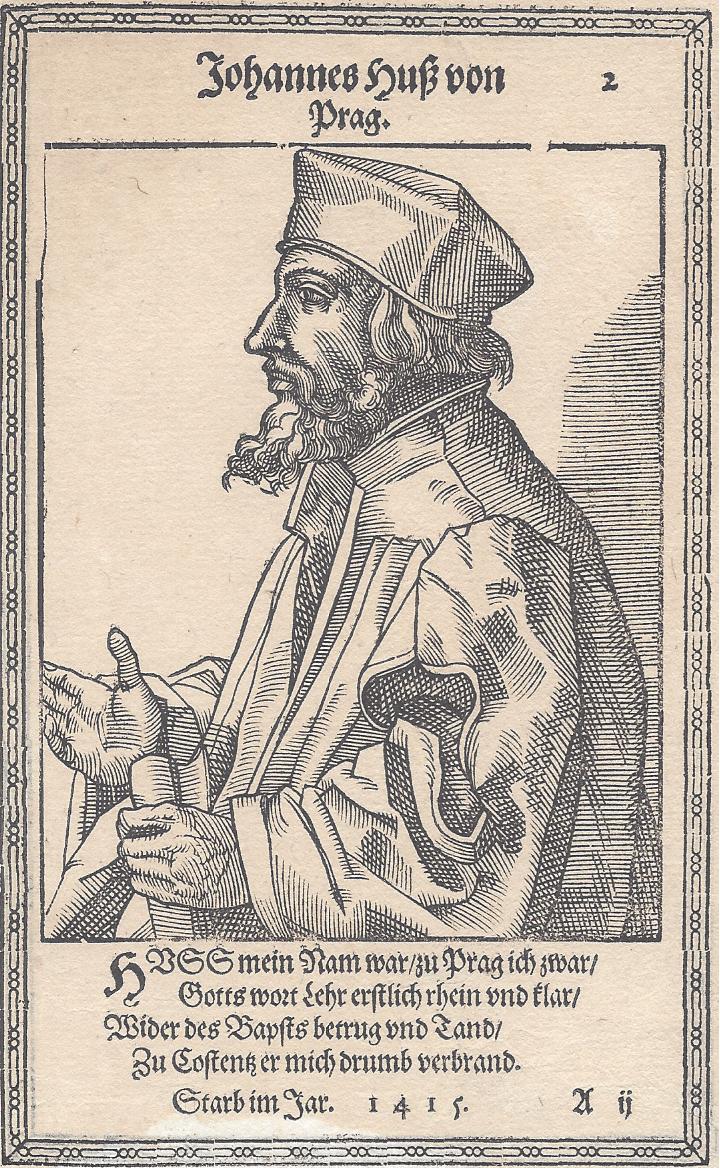
Jan Hus
The Holy Roman Emperor, Sigismund, granted him a safe conduct to travel from Prague to Constance and back to Prague. Upon his arrival at Constance, Hus was immediately imprisoned and the Council convened to try him for heresy. A Group of 452 nobles from the Kingdom of Bohemia, and Poland-Lithuania attempted to intercede on Huss’s behalf to the Council, but to no avail. Huss was burned at the stake and reportedly said to the executioner ”You are going to burn a goose (Hus meant “goose” in Czech) but soon you will have a swan you cannot roast or boil.” The nobility and people of Bohemia were enraged but did not take any action against the Church or German ethnic minority. Instead, they began to conduct their own services with their own clergy, separate from the German Catholic churches. They called themselves “Calixtines” from the Latin, “calyx”, or in Slavic “kalich” meaning chalice an illusion to their practice of taking both he bread and the wine at communion. In 1419 Wenceslas, King of Bohemia died. Sigismund, the Holy Roman Emperor who had promised Hus safe passage through Germany and brother to Wenseslas claimed the Bohemian Crown for himself and swore to exterminate the heretics.
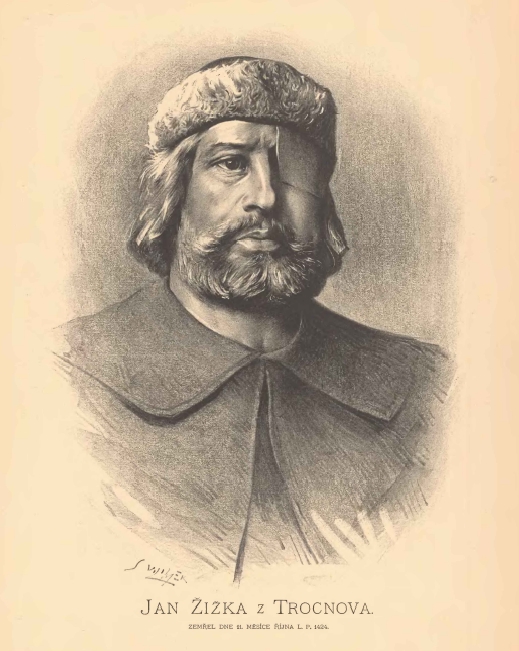
Jan Zizka
“Imitate your ancestors the ancient Bohemians, who were always able to defend the cause of God and their own. We are collecting troops from all parts, in order to fight against the enemies of truth and the destroyers of our nation and I beseech you to inform your preacher that he should exhort in his sermons the people to make war on the Antichrist and that everyone old and young should prepare himself for it. I also desire that when I shall be with you there should be no want of bread, beer, victuals, or provender and that you should provide yourselves with good arms. Remember your first encounter when you were few against many, unarmed against well-armed men. The hand of God has not been shortened. Have courage and be ready. May God strengthen you!”
– Ziska of the Chalice, 1420
Jan Ziska first appears as the leader of a war band of “Lapkas” or mercenaries in the service of King Wenceslas of Bohemia. By 1410 after a royal pardon for “excesses” committed in the service of the King, he was appointed Royal Gate Keeper. In 1410, Ziska was with the Bohemian force that aided the Polish-Lithuanian Union against the Teutonic Knights. Ziska returned to Bohemia with an enhanced reputation and knowledge of the use of guns and war wagons on the battlefield. Ziska joined Henry V of England against the French and participated in the battle of Agincourt on 25 October 1415. His participation in Henry’s campaign prevented him from joining the other 452 Bohemian nobles in their protest to the accusation made by the Council of Constance that Jan Hus was a heretic. In 1419 after the death of King Wenceslas, Ziska took military control of the Hussites, specifically the Taborite faction. Ziska’s first action against those who opposed the Hussites was against a force raised by Queen Sophia, the widow of King Wenceslas. The Hussites were enroute to a great field outside of Prague for an open air religious service when the mounted knights in Sophia’s service set them upon. Ziska ordered the Hussite women to cover the ground between then Hussites and the knights with their gowns and head coverings. When the horses’ feet were entangled in the clothing, their riders were thrown and the Hussites fell upon them and killed them to a man. Ziska led the forces that defeated Sigismund’s Crusade of 1420 and was elected President of the Bohemian Diet at Czaslau in 1421. Already blind in one eye, Ziska lost his other eye in the siege of Rabi in 1421 yet continued to lead his army. Ziska halted Sigismund’s Crusade of 1421, invaded Austria and Moravia in 1423 and fought against his fellow Hussites and defeated them at the Battle of Malesov. His Lieutenant and later successor advised peace with the Utraquists when Ziska was enroute Prague to burn it to the ground. A peace was concluded and shortly thereafter Ziska died of the plague enroute to invade Bohemia.
“At them! Rush at them
Bravely wield your arms
Pray to your Lord God
Strike and kill
Spare none”
Ziska’s Battle Song
Hussite Sects
Utraquists
The name is based on the practice of taking communion “under both kinds”, or “sub utraque specie.” This was the moderate element of the Hussites, comprised mostly of the merchant class and minor nobility in the urban areas, especially Prague. They benefited greatly from the confiscation of property from the Catholic churches. This faction attempted to negotiate with Emperor Sigismund in 1419-1420 with no success.
Taborites
The Taborites represented the most radical sect in Hussitism, believing in equality under the law for noble and commoner, the equal distribution of wealth, communal ownership of property and decision making by elected council rather than noble fiat. To the Taborites, clergy were unnecessary, biblical interpretation was an individual matter, their communion services were held on hilltops and their children were baptized in rivers and ponds. They established themselves in the fortress town of Tabor.
Orebites
Established by Ziska in 1423 under the name “Oreb Union” named after a
hill near the town Orebovice. He had become dissatisfied with the
indiscipline of the Taborites and introduced a strict military discipline
among this group he took with him out of the Taborite faction. He enforced
a strict system of justice under which all were seen as equal under the
law, all loot was equally distributed and hoarders were executed. Upon the
death of Ziska, they took the name of “Orphans” and carried a banner with
the image of Ziska on a white horse.
Adamites. A small short lived sect of Hussites that believed that
all should live as Adam and Eve did. Their belief in the need to go naked
doubtless contributed to their suppression by Ziska in 1421.
The Wars
“Day and night are the same to you, as you cannot see, but they are not the same to us.”
“How! You cannot see! Well, set fire to a couple of villages”
An Exchange between Ziska and his men after he was blinded
1419
Ziska besieged Nekmer with a force of 400 Hussites and is attacked by a relief column larger than his force and is able to retreat using wagon mounted artillery to delay the relief force.
Crusade of 1420
Ziska and 12 wagons with 400 infantry are attacked while under a flag of
truce by upwards of 200 cavalry. The Hussites establish a defensive
position anchored on a pond. The Crusaders attack on foot but are forces
to withdraw having sustained numerous casualties.
Sigismund declared a Crusade against the Hussites and took Prague.
Ziska fortified Vitkov Hill overlooking Prague forcing Sigismund to
withdraw with an army divided by dissention over the division of loot
between German, Slovenian and Hungarian soldiers. The Taborites are
received as heroes in Prague until the townspeople come to resent the
strict rules imposed by the Taborites. The Taborites are driven out of
Prague by the more moderate Utraquists.
An Utraquist army besieged Vysehrad Castle under the command of
Hynek Krusina. Sigismund sends a relief force that is defeated and the
Castle falls to the Hussites.
The Bohemain Diet convenes at Czaslau where Ziska is elected
President of the Diet and the Four Articles of Prague are adopted which
proclaimed religious freedom, celebration of the Mass receiving bread and
wine, redistribution of excessive church wealth and equality before the
law for all, noble commoner and clergy alike.
Crusade of 1421
Sigismund declares a second Crusade invading Bohemia with two armies, one
from Silesia and another led by Sigismund himself comprised of Hungarians
and Serbians. The Silesians flee at the approach of the Hussite Army.
21 December 1421 The army led by Sigismund met Ziska’s force
outside the town and out maneuvered the wagenberg, taking the town and
forcing Ziska to retreat. Sigismund dispersed his forces anticipating the
Hussites would go into winter quarters.
6 January 1422 Ziska surprised and routed a Hungarian force at
Nevobiby.
8 January 1422 Sigismund gathers his forces from winter quarters on
the high ground outside the village of Habry and was quickly routed.
10 January 1422
The Hussite army besieges, takes and sacks Nemecky Brod.
Hussite raids into Moravia and Austria in 1423
April 1423 A Bohemian force loyal to Sigismund comprised of cavalry, cannon and war wagons attacked Siska’s army positioned on high ground. After multiple assaults, Ziska counter attacked out of his defensive positioned and routed his attackers.
Bohemian Civil War of 1424
Ziska led away those of the Taborites that would follow and established
the Oberite sect. Ziska defeats an army sent against him from Prague at
the battle of Malesov and the Hussite factions are reconciled.
June to October 1424 Utraquist, Orebite and Polish joint forces
conduct campaign in Moravia. Campaign abandoned by the death of Ziska.
Crusade of 1426
The Pope declared a crusade, thinking the Hussites vulnerable as a result
of Ziska’s death.
15 June 1426 A Hussite force besieged Usti nad Labem and were
attacked by a much larger German Crusading army of 70 to 100 thousand men
(according to contemporary accounts) attacked the Bohemian entrenched
“wagenberg” of 500 wagons established on high ground and was defeated
losing as many as 15 thousand dead, 50 thousand lost or wounded. The
Hussites sustained 30 losses.
Crusade of 1427
4 August 1427 A Crusade led by Henry De Beaufort, Bishop of
Winchester gathered its forces and was defeated by a Bohemian Army
comprised of Hussites and Catholics at the city of Meiss. The Crusaders
fled without a fight and suffered considerable casualties from the
villagers they had pillaged enroute to Meiss.
In 1429 Procopius, elected leader of the Hussites, assembled
the Bohemian Diet in Prague and gained its consent to go to Vienna to
approach Sigismund about a peace treaty. Sigismund refused to accept terms
that were the same as the 1420 Articles of Prague
On 23 March 1430 Joan of Arc (or, as it was signed by her
Confessor for her, “Joan the Maiden”) dictated a letter to the “heretics
of Bohemia” threatening to lead a crusade against them.
The Beautiful Rides (spanile jizdy) of 1428-31
The Hussites raid far and wide into Germany, Austria, Hungary and Poland.
Crusade of 1431
14 August 1431 An army of 130 thousand German Crusaders (according to contemporary accounts) led by Frederick of Brandenberg fled in panic at the sight of the Hussite force at Domazlice. The Crusaders suffered considerable casualties from the villagers they had pillaged enroute to Domazlice.
Compacta of Basle
On January 9 1433 300 Hussites entered Basle and after 50 days of negotiation, when on the verge of leaving Basle, terms were reached granting them the terms of the Four Articles of Prague. The Articles remained the religious law of Bohemia until 1567 when the Hussites divided, some going back to Catholicism and some joined with the Lutherans drawing up the Confessio Bohemia which was recognized by the Holy Roman Emperor’ in 1609 and grated considerable religious freedom to Bohemia.. The violation of this letter set the stage for the 30 Years War.
Civil War of 1434
The Oberites and Taborites refuse to accept the agreement of Basle.
Oberite and Taborite armies meet an army raised by members of the nobility
and Prague at Lipany and are defeated by them.
In 1457 George of Podebrady, Bohemia’s only Hussite king
ascends to the throne and defeats a Hungarian Crusader army in 1468. After
the death of Poderbrady, Bohemia became a part of the Holy Roman Empire.
Involvement of the Polish Lithuanian Union
When the Polish Lithuanian Union was under threat from the Teutonic Knights and their German and Hungarian allies, the Kingdom of Bohemia sent 3000 soldiers, Jan Ziska among them, to aid their fellow Slavs. They were present at the battle of Grunwald in 1410 and participated in the siege of Malbork, the Teutonic Order’s capital. From 1421 to 1427 the Hussites received considerable military support from the Polish-Lithuanian Union. This support took the form of mercenaries, volunteers and materiel. Jan Ziska and the Bohemian Diet went so far as to offer the crown to Ladislaus Jagiello, King of Poland and a Lithuanian who refused it under pressure from his Catholic Clergy. The Crown was offered to Withold, The Grand Duke of Lithuania who sent his nephew Zygmunt Korybut to serve as his regent in Bohemia. Korybut was unable to, as he had hoped, to return the Bohemian to the Catholic Church and found himself at times fighting the Taborites as well as the Orebites. Official Polish-Lithuanian Union involvement came to an end in 1427 with the discovery of Korybut’s plot to betray the Hussites to Emperor Sigismund. Sigismund and the Pope engineered Polish-Lithuanian Union’s disengagement with the Hussites by threatening a crusade and providing support to the Teutonic Knights. Despite the departure of Korybut, it is safe to assume the continued presence of Poles and Lithuanians among the Bohemians. Once more in 1433 the Hussites joined the Polish-Lithuanian Union in a war against the Teutonic knights and penetrated north all the way to the mouth of the Vistula River on the Baltic Sea.
The Hussite Armies
“They camped in the field with their women and children, who accompanied the army, as they had a large number of wagons with which they drew up a wall-like fortification. When they moved out for battle, they formed two lines of these wagons, which enclosed for foot troops, while the horsemen remained outside without moving off to any distance.”
Enea Silvio Piccolomini (later Pope Pius II)
from his ‘Historia Bohemia,'
The Hussite armies were predominantly peasant infantry armies with the
minor nobility serving as light cavalry. There was no attempt to replicate
in the Hussite force the heavy armored knight so prevalent throughout the
rest of Europe. The use of war wagons combined with crossbows and firearms
can be attributed to Jan Ziska’s experiences in Poland but it was more
than a technical innovation that led to so many successes against those
invading Bohemia and those defending their land from the Bohemian forces.
The egalitarian nature of Hussitism resulted in a military force in
which women as well as men were expected to fight, where battlefield loot
was evenly distributed and any and all infractions were punished in the
same fashion, regardless of social status. Leaders were chosen based upon
ability and not social standing. The Hussite army was well trained,
disciplined and ideologically motivated unlike the vast majority of
military forces of the time. All this combined with the effective use of
the most advanced technological innovations of the time made a literally
unbeatable combination.
Weapons
War Wagon. The War Wagon is an ancient weapon with possible origins as old
as the Sythians. The Saga of Haakon Broad Shoulder in Snorre Sturlason’s
‘Heimskringla or the Lives of Norse Kings”, claims the Norse Varangian
Guard broke a “wagonberg” in Rumania along the Danube around 1161.
Ideally each of the wagons was manned by 10-20 soldiers, which could
be men or women in keeping with Hussite practice of encouraging women to
fight alongside the men. The goal was to have 2 handgunners, 6
crossbowmen, and up to 16 armed with polearms. There would be 2 soldiers
responsible for handling the pavaises, or standing shields assigned to the
wagon. The wagon was to have a supply of axes, shovels, pickaxes, hoes,
and shovels with at least two of each to allow for ditching in front of
the wagonberg when in a defensive posture.
There were commanders for each wagon, per 10 wagons and per 50-100
wagons and one commander for the infantry, wagons and cavalry in the army.
There can be little doubt that the use of war wagons and guns was brought
back to Bohemia by Jan Ziska and those Bohemians who supported the Poles
in 1410 against the Teutonic knights. Ziska however used the war wagon in
an innovative manner that suited the type or warfare the Hussites were
engaged in. The Hussites did not lack for motivated manpower but were
lacking in a mounted force that could meet the mounted forces of their
enemies. The war wagons arrayed in a linear or semi linear formation tied
in with terrain that was impassible to horses or in a laager on dominating
terrain could provide an active defense against a mounted or dismounted
force of greater size. An attacking formation was initially subject to
concentrated crossbow and gunfire. If the attritted formation was still
intact and advancing, they faced infantry with polearms fighting from
inside or between the chained wagons of the wagonberg. Stones were even
available for those in the wagon to throw at the attacking force. It was
the critical point in time when the attacking formation was in greatest
disarray that the Hussite commander unleashed his typically small mounted
formation from within the wagonberg to attack and pursue the attacking
force. Once the pursuit began the infantry came from behind the wagonberg
and participated in it. It is a credit to the discipline of the Hussite
mounted forces that there are no accounts of them pursuing a defeated
enemy to the point of putting themselves at risk of counter attack or
beyond the point where they could cover and support the wagonberg.
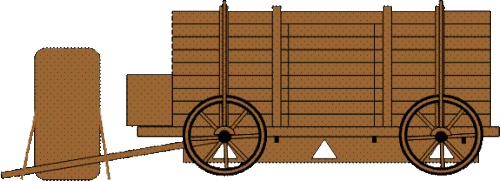
Facing inside the “wagenberg” with ramp up
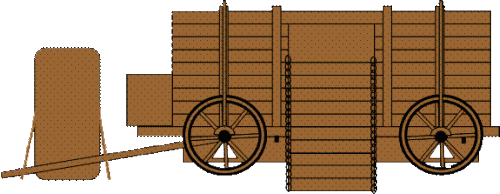
Facing inside the “wagenberg” with ramp down
When the war wagons were on the move, they typically adopted a 4-column
formation. The baggage train would move with two columns on either side of
it. The outer columns or “krajn” were longer that the two inner columns or
“placni” so they could form an outer circle all the way around the inner
circle when the wagonberg was established.
Cross bows. There were a considerable number of crossbows in the
Hussite army, despite the tendency on the part of historians to make far
more of the presence of firearms. Crossbows shared with the firearms of
the time the advantages of being easy to train and relatively
uncomplicated to manufacture and maintain. All these attributes make them
both ideal for armies comprised of large numbers of relatively
inexperienced soldiers. The primary disadvantage of the crossbow was the
time it took to prepare it for firing.
“pistala” (fife)
Hackenbuchse (hook gun)
Hand Gonnes. The hand held firearms of the time were essentially tubes on sticks ranging from .40-1.00. caliber. They could with practice be accurate out to a range of perhaps 50 yards. Given the smoke and noise when fired, they also doubtless had greater unnerving effect on the enemy than their lethality.
“tarasnice”
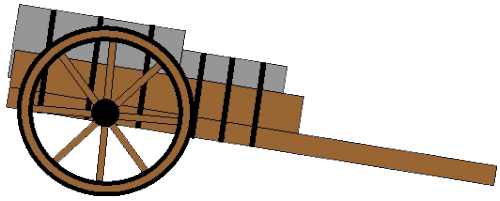
“houfnice”
Cannon
The Hussites employed two types of cannon, the lighter of the two being the most prevalent. The “Tarasnice” was like the hand gonne of the time a tube on a stick but was of a larger caliber, perhaps anywhere from .75 to 1.00. It was mounted on a small platform that initially was not wheeled but had wheels added later and was employed between the wagons of the wagonberg. The “Houfnice” was the wheeled heavy artillery of the Hussites and was employed on special wagons. There is reason to believe that their first appearance was at the battle of Aussig in 1426, but wheeled heavy artillery was already in use in other parts of Europe even earlier. I can only surmise from photos that this artillery piece would fire a projectile at least several inches in diameter.
Cannister or grape shot
There is evidence to support the use of canister/grapeshot/ buckshot in firearms against the Teutonic Knights in 1410 as well as by Hussite mercenaries fighting for the Poles in the late 15th century. Given this it would be very probable that the Hussites used it as well.
Polearms
The Hussites used a variety of polearms, primary the purpose of which were to forcibly dismount a rider, making him more vulnerable to dismounted attack. The weapon most commonly associated with the Hussites is the flail, an agricultural threshing tool with spikes placed on the short end chained to a 6 foot pole. Halberds, bardiches, axes and any number of polearms found their way into the hands of the Hussites as a result of “battlefield pick ups.”
Armor and swords
These would have come into the hands of most Hussites as a result of “battlefield pick ups” and distributed loot.
Sources
- Delbruck, Hans, “History of the Art of War, Volume III” Lincoln: University of Nebraska Press, 1990
- Fox, John “A History of the Lives Sufferings and Triumphant Deaths of the Early Christian and Protestant Martyrs”, London: 1563
- Gravett, Christopher and McBride, Angus “German Medieval Armies, 1300-1500” Oxford: Osprey Publishing, 1985
- Hall Bert S. “Weapons and Warfare in Renaissance Europe”, Baltimore: Johns Hopkins University Press, 1997.
- Hall, Bert S. ed. and trans. “The Technological Illustrations of the So Called Anonymous of the Hussite Wars” Weisbaden:Reichert, 1979
- Kejr, Jiri “The Hussite Revolution” Prague: Orbis Press Agency, 1988
- Robertson, J.C. “Sketches of Church History” New York: Edwin S. Gorham, 1904.
- Turnbull, Stephen and McBride, Angus “The Hussite Wars, 1419-1436” Oxford: Osprey Publishing, 2004.
- Wagner, Eduard, et. al., “Medieval Costume, Armour and Weapons” New York: Dover, 2000.
- Letters of Joan of Arc
- Polonia Today Online
